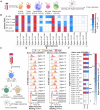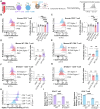This is a preprint.
An ultrasensitive and modular platform to detect Siglec ligands and control immune cell function
- PMID: 40661511
- PMCID: PMC12259067
- DOI: 10.1101/2025.06.10.658684
An ultrasensitive and modular platform to detect Siglec ligands and control immune cell function
Abstract
Siglecs are immunomodulatory receptors that regulate immune cell function. A fundamental challenge in studying Siglec-ligand interactions is the low affinity of Siglecs for their ligands. Inspired by how nature uses multivalency, we developed Siglec-liposomes as a highly multivalent and versatile platform for detecting Siglec glycan ligands in which recombinant Siglecs were conjugated to liposomes using the SpyCatcher-SpyTag system. Siglec-liposomes offer tunable multivalency and a modular assembly, enabling presentation of different Siglecs on the same liposome. Using Siglec-liposomes, we profiled Siglec ligands on human leukocytes, revealing new insights into Siglec ligands. Moreover, Siglec-liposomes are in vivo compatible, where we demonstrated that Siglec-7-liposomes bind to the brain vasculature in a mucin-dependent manner. Given the abundance of Siglec ligands on T cells, we investigated whether Siglec-liposomes modulate T cell function and find that Siglec-7-liposomes increase T cell proliferation in a ST3Gal1-dependent and CD43-independent manner. Taken together, Siglec-liposomes are a versatile and sensitive tool for detecting Siglec ligands and immunomodulation.
Conflict of interest statement
Competing interests: The authors declare that they have no conflicts of interest with the contents of this article.
Figures






Similar articles
-
Sialylated keratan sulfates on MUC5B are Siglec-8 ligands in the human esophagus.Glycobiology. 2024 Aug 30;34(10):cwae065. doi: 10.1093/glycob/cwae065. Glycobiology. 2024. PMID: 39173029
-
Sialylated glycoproteins bind to Siglec-9 in a cis manner on platelets to suppress platelet activation.J Thromb Haemost. 2025 Jul;23(7):2270-2283. doi: 10.1016/j.jtha.2025.03.027. Epub 2025 Apr 7. J Thromb Haemost. 2025. PMID: 40204021
-
CD16 and Siglec expression refine the phenotypic heterogeneity of steady-state myeloid-derived suppressor cells.Front Oncol. 2025 Jun 23;15:1570121. doi: 10.3389/fonc.2025.1570121. eCollection 2025. Front Oncol. 2025. PMID: 40626011 Free PMC article.
-
Comparison of self-administered survey questionnaire responses collected using mobile apps versus other methods.Cochrane Database Syst Rev. 2015 Jul 27;2015(7):MR000042. doi: 10.1002/14651858.MR000042.pub2. Cochrane Database Syst Rev. 2015. PMID: 26212714 Free PMC article.
-
Fabricating mice and dementia: opening up relations in multi-species research.In: Jenkins N, Jack-Waugh A, Ritchie L, editors. Multi-Species Dementia Studies. Bristol (UK): Bristol University Press; 2025 Feb 25. Chapter 2. In: Jenkins N, Jack-Waugh A, Ritchie L, editors. Multi-Species Dementia Studies. Bristol (UK): Bristol University Press; 2025 Feb 25. Chapter 2. PMID: 40690569 Free Books & Documents. Review.
References
-
- Lin S. Y., Schmidt E. N., Takahashi-Yamashiro K., Macauley M. S., Roles for Siglec-glycan interactions in regulating immune cells. Semin Immunol 77, 101925 (2024). - PubMed
-
- Stanczak M. A., Laubli H., Siglec receptors as new immune checkpoints in cancer. Mol Aspects Med 90, 101112 (2023). - PubMed
-
- Jame-Chenarboo Z., Gray T. E., Macauley M. S., Advances in understanding and exploiting Siglec-glycan interactions. Curr Opin Chem Biol 80, 102454 (2024). - PubMed
-
- Lin S. Y., Schmidt E. N., Takahashi-Yamashiro K., Macauley M. S., Roles for Siglec-glycan interactions in regulating immune cells. Semin Immunol 77, 101925 (2025). - PubMed
Publication types
Grants and funding
LinkOut - more resources
Full Text Sources
Research Materials
